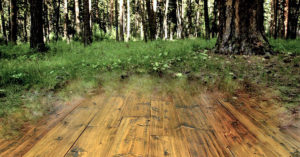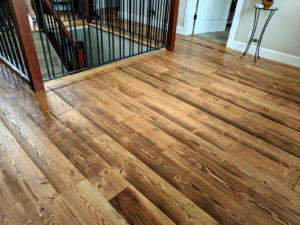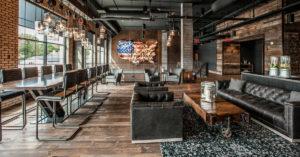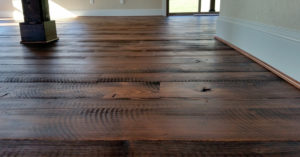A Closer Look at Douglas Fir Flooring
Posted: June 27, 2022Updated 6/2/2025
Author – Ryan Palma Owner/CEO Sustainable Lumber Co.
Click on this link for more information, photo’s, and pricing on our full sawn Douglas Fir Wood flooring, or to contact us for a pricing quote.
A closer look at Douglas Fir
 If you are shopping for a solid real wood floor with a proven track record, you can’t do much better than our Douglas Fir wood floors. With its stunning natural character, warm tones, and tight grain patterns, it’s in an elite class when it comes to organic beauty and historic usage. Other popular species of wood flooring like maple, and even our live-sawn white oak or rustic hickory hardwood flooring have a hard time rivaling all that Douglas Fir flooring has to offer.
If you are shopping for a solid real wood floor with a proven track record, you can’t do much better than our Douglas Fir wood floors. With its stunning natural character, warm tones, and tight grain patterns, it’s in an elite class when it comes to organic beauty and historic usage. Other popular species of wood flooring like maple, and even our live-sawn white oak or rustic hickory hardwood flooring have a hard time rivaling all that Douglas Fir flooring has to offer.
Douglas Fir is a species of wood flooring that doesn’t cross your mind too often. However, as people start researching the pros and cons of all types of hardwood floors they are pleasantly surprised when they learn everything Douglas Fir flooring has to offer. That’s why we are going to go over some Douglas Fir wood flooring facts and its maintenance.
In the Western United States, Douglas-Fir is the most common tree by volume with nearly twice the volume of the next most common species which is Loblolly Pine located in the Southern United States. Timber companies re-plant Douglas Fir because it is adaptable, resilient, and hardy, and yields the highest amount of timber of all trees in North America. Douglas Fir trees grow quickly and possess bark that is highly resistant to several diseases, pests, and wildfires. Douglas Fir trees have a lifespan of 500-1000 years and are one of the tallest species of trees in the world. Douglas Fir has the highest strength-to-weight ratio of any wood species on the planet and is world-renowned for its durability, strength, and natural beauty. Douglas Fir is widely considered to be one of the finest and most versatile wood species available on the planet, it is commonly used in lumber, pilings, telephone poles, marine structures, railroad ties, furniture, fencing, decking, interior trim, molding, doors, floors, windows, siding, structural beams, and countless other applications around the world.
Why is Douglas Fir good for wood flooring?



There are many options out there, but you’ll be hard-pressed to find such a wide selection of eco-friendly, sustainably harvested, quality-crafted, and uniquely authentic wood flooring made in the U.S.A.
Maintaining Douglas Fir Floors

Solid Douglas Fir floors can be easily refinished numerous times, and in most incidences will outlast our lifetime. Refinishing can be completed in 3 simple steps: lightly abrade the floor, clean thoroughly, and recoat with a self-leveling finish coat. We use and highly recommend a water-based catalyzed floor coating.
Routine Care and Maintenance for Douglas Fir Floors
Vacuum, sweep, or dust mop your floor once a week, or more if needed. The vacuum head must be brushed or felt, and a wand attachment is preferable. Do not use vacuums with beater bars or hard heads. A hardwood floor swivel-head mop with a terry cloth cover is also highly recommended to eliminate fine particles of grit and dirt that can act like sandpaper on hardwood floors.
- Spills and tracked-in dirt should be wiped up immediately. For spot cleaning, apply a no-wax wood floor cleaner onto a clean cloth and rub it onto the spot.
- Periodically, as necessary, thoroughly clean the floor with a no-wax wood floor cleaner and a swivel-head mop with a terry cloth cover. Spray the floor cleaner directly onto the floor or dampen the mop and apply. DO NOT allow excess no-wax wood floor cleaner to remain on the floor’s surface. Excess liquid may damage the fiber of the wood.
- Use interior and exterior doormats at all entrances to collect dirt and moisture and prevent it from being tracked onto the floor.
- Area rugs are recommended in front of kitchen sinks, at all pivot points, and within high-traffic areas. Do not use rugs with solid rubber or vinyl backings. The rugs must be made of breathable material to prevent moisture entrapment.
- Never wet mop with water or cleaning products.
- Never use any of the following products (or products similar in nature) on your floor: ammonia-based cleaners, acrylic finishes, wax-based products, detergents, bleach, polishes, oil soap, abrasive cleaning soaps, or acidic materials such as vinegar. Many of these products can pit or etch the finish of your flooring or prevent the proper use of recommended maintenance materials.
- Keep animal nails trimmed to minimize finish scratches.
- Do not damage your floor with shoes having heel taps or sharp objects protruding from the sole such as rocks, exposed nails, and gravel.
- Avoid walking on wood floors with spike or stiletto-healed shoes. Spike or stiletto high heels must be properly maintained to prevent damage from the steel heel support.
- Do not roll or slide heavy objects directly upon the floor. When moving appliances or heavy furniture, consider laying a solid protective covering on your floor and gently “walk” the item across it. Carpet or cardboard is not adequate to prevent surface compression scratches.
- Use furniture leg protector pads under ALL furniture and make certain to keep them clean and well-maintained.
- Replace hard, narrow furniture rollers with wide rubber rollers.
- Keep the relative humidity in your home between 35% and 55%.
- Protect your floor from direct sunlight. Use curtains with UV-resistant film on large glass doors and windows. Move area rugs occasionally as they block sunlight and may give the appearance of discoloring under the rug.
Our knowledgeable and educated staff is here to answer any additional questions you may have. Please call us today for a free quote: Ph# 406.642.7120 or click here to submit an inquiry online. We look forward to working with you on your next project!


